If you want to make the very best pizza you’ve ever had, you’re going to need to start the process at least 10 hours but up to a day ahead of when you’d like to eat it. It doesn’t really require any skill-set beyond patience and the ability to follow four simple sets of directions.
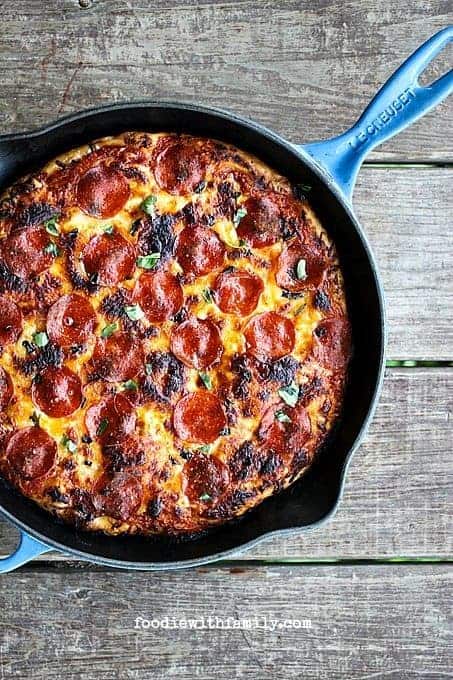
How to Make Pan Pizza
- 1. Measure, mix, and wait.
- 2. Divide, oil, and wait.
- 3. Top, bake, and wait.
- 4. Remove, slice, and wait.
Are you catching the theme? There’s a lot of waiting.
There’s NOTHING complicated but patience is non-negotiable. If you have a kitchen scale, this is the moment to break it out.
Measuring your flour, water, oil, salt, and yeast by weight insures that the only variables are ones outside of your control: humidity and heat. You can compensate for humidity and heat, but you can’t compensate for four ounces too many of flour because you didn’t measure correctly.
That’s right, I said it. Measuring precisely here is actually of paramount importance.
This is not a case where you grab that teacup your mom or grandma always kept in the flour bin, plunge it into the flour, and squish it up against the edge to pack it level. Just don’t.
This is a job for a scale that weighs in ounces, or -in a pinch- an occasion when you use a spoon to dip into the flour, shake it gently over the cup that you’re not shimmying in any way, and repeat until the cup is a little over full, then you use a flat edge of a butterknife or a spoon handle to level it off.
I’m not kidding you. You do not want a ‘workable’ dough that you knead.
You’re going to stir it all together with a spoon, cover it, and let it go overnight or for at least 8 hours. Yes, it sits on the countertop that whole time and does not go into the refrigerator.
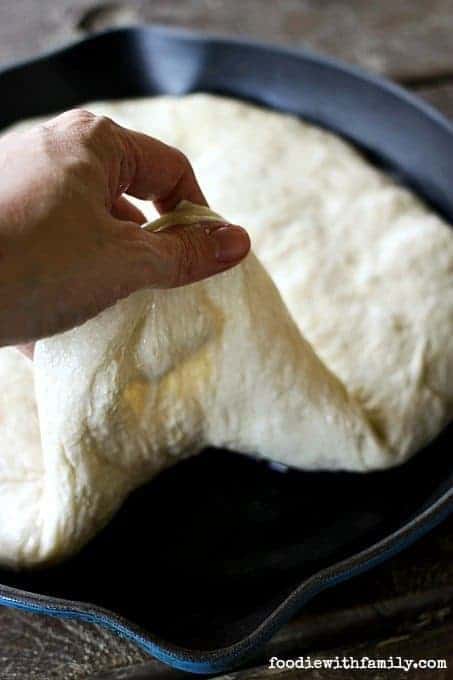
You’re seeking a slack dough. In fact, you’re looking for the kind of dough that will spread itself out in a well-oiled cast-iron skillet because that is exactly what you’re going to let it do.
Yes. No-knead dough that spreads itself in the pan.
Do I have you now? Once you get to that point, the toughest part is over with, unless you include the inner battle to avoid biting down on molten hot pizza that will remove the first layer or two of skin from your mouth.
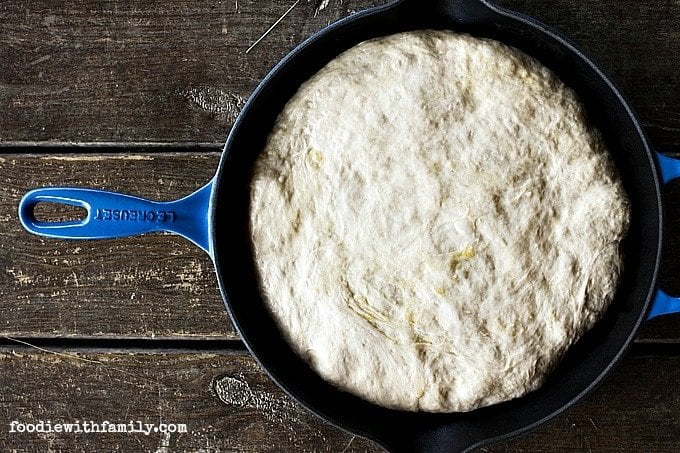
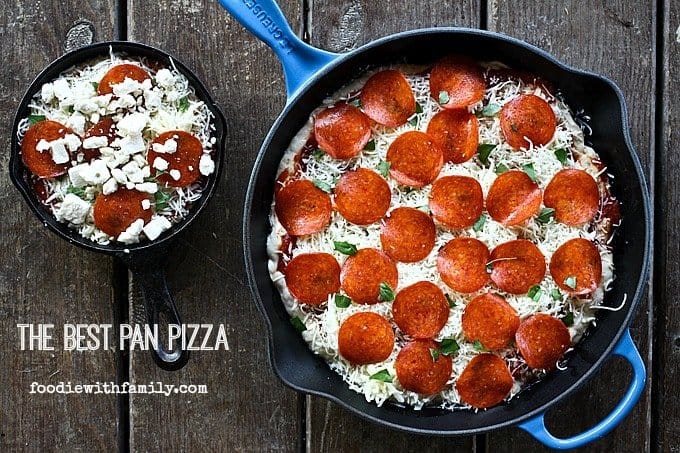
All that remains is to poke any extra large air bubbles with the back of a knuckle, lift the dough around the edges to eliminate any trapped air bubbles, and top it. Aside from the fact that the dough is DEAD easy as long as you know how to properly measure, there’s more to recommend this method.
Pan Pizza
EVERYTHING is assembled in ONE PAN. The dough spreads in one pan, is topped in the same pan, then cooked in that same pan.
You don’t have to muck up and dirty all kinds of dishes, remember to preheat a pizza stone, or fiddle around with a pizza peel to make this one pizza to rule them all. All you need is a solid, cast-iron pan or two and a dose of “I’ll wait for what’s great.”
If I had to compare the Best Pan Pizza to one that’s commercially available, I would first say, “Pffft. This is better than any commercial pizza.” then I would grudgingly admit it’s rather like the Pizza Hut Personal Pan Pizzas of my youth.
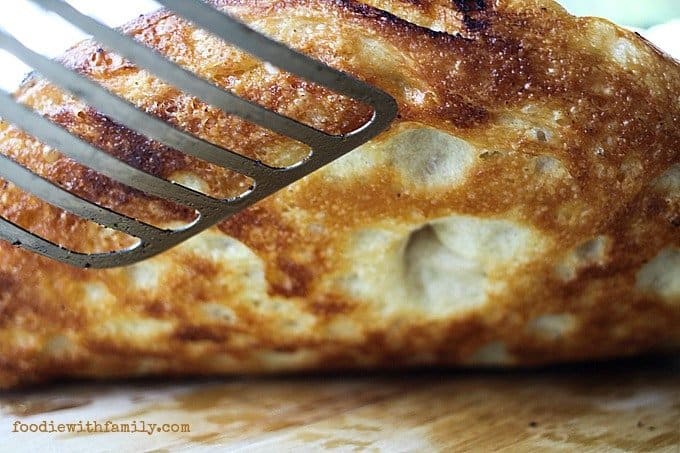
I loved those oil soaked, crispy bottomed, chewy little pieces of pizza heaven. The Best Pan Pizza is a little thicker than a thin-crust, but nowhere near the whole gloppy Deep-Dish pies of Chicago.
(Not that there’s anything wrong with those, but they’re just not what we’re looking for in your every-weeknight-pizza.) They are -in short- chewy, fried-crust, pizza perfection.
What kind of flour to use for Pan Pizza
The recipe specifies high-gluten (or bread) flour. This is not the same thing as all-purpose flour.
It has a higher protein (read: gluten) percentage which yields a chewier/holier dough. You will not get the same results from all-purpose flour, so it is best to seek out the high-gluten flour if it is available to you. (King Arthur Bread Flour has an excellent protein percentage for this pizza dough.)
Can you use all-purpose flour? Yes. It just won’t be the same. That said, you can definitely make it and it’ll be tasty; just different.
Can you use gluten-free flour? I honestly do not know. I’m sorry.
Gluten-free baking is a whole different field than my specialty. There are some folks who have weighed in on it in the comments section. Scroll through and maybe you can find some help!
How much flour and water to use for pizza dough
Body temperature water (just under 100°F) is the temperature of water you want to use in your dough!
Because baking is art as well as science, KEEP EXTRA WATER ON HAND when mixing your dough.
If you live somewhere humid, you’ll use all the water in the recipe, still. If you live somewhere arid, like the desert, you may need as much as 1/4 cup more water!
For the best results, use the dough in the video on this post as a visual cue for how it should look when just right.
As for flour, definitely weigh it out! I mean it! Don’t be tempted to add more flour to the mixture.
The dough should come together easily even if it looks shaggy. A dough whisk is your best bet for mixing thoroughly. Believe me, you not only don’t have to knead this dough, but you SHOULDN’T knead it.
The long, slow rise with a small amount of yeast allows the dough to fully develop the gluten that provides that lovely, holey structure.
The best cheese for pan pizza
When selecting which cheese to use, keep in mind that the Best Pan Pizza is not a good candidate for fresh mozzarella. The delicate texture and flavour would be lost in the blast-furnace that your oven is going to become.
You’re far better off buying a block of whole or part-skim mozzarella and shredding it yourself. Less great than block cheese grated yourself, but still better for these pizzas than fresh mozzie, is pre-grated mozzarella cheese.
Homemade Pan Pizza
Don’t make a mistake and choose too small of a bowl to mix/rise the dough in. This is going to expand to about eight times its original size, so use a very large mixing bowl, dough rising bucket, or a big old, non-reactive (stainless steel for example) pasta pot.
Store the rising dough, draft-free and at room temperature!
Pan choices count for your Best Pan Pizza. IDEALLY you will use two very heavy cast-iron, 10-inch skillets. If you don’t have two of those, you can use a 12-inch and an 8-inch or a 10-inch skillet and an 8 or 9-inch cake pan.
I used 12-inch and 10-inch enameled cast-iron Le Creuset skillets for both of my pizzas (and a bonnie wee 5-inch cast-iron skillet for another batch) and they were PERFECTION.
I used a cake pan for the second batch and while it did an admirable job, it didn’t get the crusty-bits I love so dearly up the side the way the Le Creuset skillets did.
Pan Pizza Recipe
Let’s talk oils. You want to choose one with a HIGH-smoke point because of the high-temperature of the oven.While extra virgin olive oil sounds like it would go with pizza, it’s a poor choice here because of its distressing tendency to billow smoke at any temperature above 375°F.
A better choice is regular old pure olive oil, but an even better choice is grapeseed or peanut oil. Canola oil or vegetable oil will do well if that’s all you have handy!
Speaking of oil, don’t skimp on the oil in the pan! It does triple duty here.
First, it allows the dough to spread itself easily, reducing or eliminating the friction it would experience against the pan. Second, it adds another layer of cooking to the exterior of the crust, essentially frying it as it cooks. Third, it’s just plain yummy.
Fire that oven up and don’t wimp out! Get your oven as hot as it can go for the cooking process.
That BURST of heat develops a bajillion little bubbles in the dough that helps lend to the chewy, hole-ridden texture so desired in a pan pizza. If you can get your oven up to 550°F (which is as high as my oven goes) DO IT.
If you can’t, just get it as hot as you possibly can shy of setting it on fire. Trust me.
Your oven goes no higher than 450°F you say? I’m sorry, that stinks. HOWEVER, we can work around it. This is where the ideal pan comes into play.
In this case, you take the pizza fresh from the oven when your toppings look just right, and set it directly on a hot burner to help crisp up the underside of the crust, lifting the edge carefully with a spatula or tongs from time to time to peek at the underbelly. When it looks deep brown and crisp, slide that pizza right onto a cutting board.
Let the pizza rest a bit before you cut it, if you value your skin. These things are HOT HOT HOT when they come out of the oven.
Let it rest at least 5 minutes, then slice it, then let it rest another 3 minutes before picking up your pizza to nosh on it. This will keep your precious mouth skin where it belongs: attached to you.
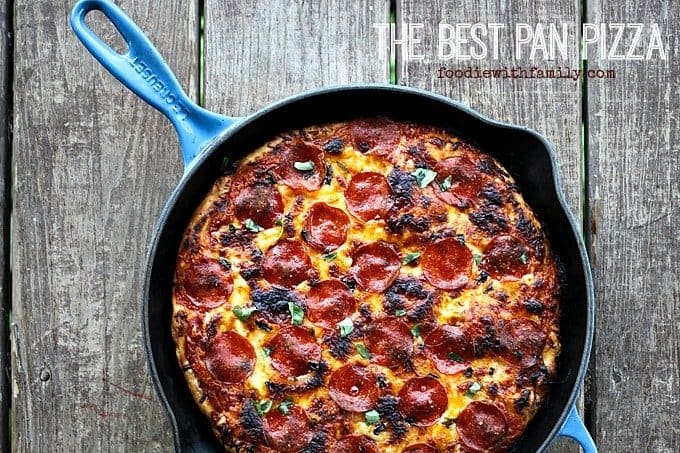
Use this to make The Best Pan Pizza
See how easy it is to make the Best Pan Pizza?
Calling all you pizza maniacs out there! After you try our Best Pan Pizza, be sure to try our Pickle Pizza, Figgy Pig Pizza; Tuscan Style Prosciutto, Fig, Greens Pizza, Smoked Salmon Cucumber Pizza, Honey-Drizzled Salami Pizza, and Roast Beef and Caramelized Onion Naan Pizza {10 Minute Meal}
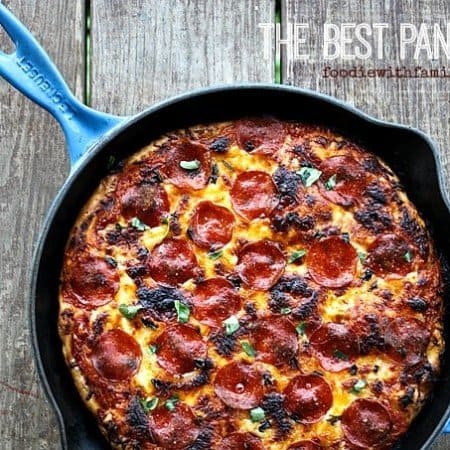
The Best Pan Pizza
Rate RecipeIngredients
For the dough:
- 14 ounces bread flour 3 cups by volume
- 2 teaspoons kosher salt 3/8 of an ounce or .35 ounces
- 1/2 teaspoon instant yeast 0.06 ounce or 1.5 grams
- 1 1/2 cups water (12 ounces)
For the Pizzas:
- 4 tablespoons olive oil or neutral oil with a high smoke point like grapeseed such as peanut, or canola, divided (no extra virgin olive oil)
- 1 1/2 cups thick pizza sauce homemade or purchased
- 2 cups shredded mozzarella cheese
- 12-16 pieces of pepperoni per pizza
Optional but tasty:
- fresh basil leaves for adding before and after baking
Instructions
- Mix together all of the dough ingredients until it is evenly moist and there are no more pockets of dry ingredients. Cover the bowl or dough bucket tightly and let it rise for at least 8 but up to 24 hours.
- Pour 2 tablespoons of neutral oil into a 10 to 12 inch cast-iron skillet. Repeat with a second skillet. Swirl to coat the bottoms of the pans. Divide the risen dough into two pieces. Gently form into a ball by pulling the side of the dough and tucking it under, rotating 1/4 turn and repeating the tug and tug, rotating another 1/4 turn and repeating the tug and tuck, then finally doing it once more to form a loose ball. Lay it smooth side down in the oil, then flip so the whole thing is coated in oil. Use the palm of your hand to gently flatten the dough. It will not spread to the edges yet, but that is okay. Cover the pan tightly with plastic wrap and set out at room temperature -undisturbed- for 2 hours.
To Prepare the Pizzas:
- Preheat oven as high as it will go, preferably to 550°F. Remove plastic wrap from the pans with the pizza dough in them. The dough should now have spread itself (or nearly spread itself) to the edges of the pan. Simply lift the edges of dough to pull toward the sides of the pan if necessary. This will help loosen any trapped air under the dough as well. If there are any large air bubbles, nudge them down with the back of a knuckle.
- Spread half of the sauce on each pizza right to the edges of the dough. Divide the cheese and top each pizza evenly to the edge, then distribute the pepperoni over the pizzas. If using it, tear half of your basil leaves and toss over the tops of the pizzas. Reserve half of the basil to add to the pizzas when they’re removed from the oven.
- Put into the hot oven and bake for 12-20 minutes (depending on how well done you want your pizzas.) You can check the underside of the pizza crust for doneness by lifting the edge gently with a flexible spatula (like a fish turner). A finished pizza will have a crisp, deep-brown bottom and a bubbly, golden- to deep-golden brown top. I pull my pizzas when the edges have some deeply caramelized (read: lightly charred) edges and some dark brown bubbles on top.
- Use your flexible spatula to slide under the pizza and edge it out onto a cutting board, tear the remaining basil and scatter over the pizzas. Let rest for 5 minutes before slicing into wedges, then let it rest without moving it for another 3 minutes before serving.
Nutrition
Nutritional information is an estimate and provided to you as a courtesy. You should calculate the nutritional information with the actual ingredients used in your recipe using your preferred nutrition calculator.
did you make this recipe?
Make sure to tag @foodiewithfam on Instagram and #hashtag it #foodiewithfamily so I can check it out!
Are you a big fan of the Best Pan Pizza? Try these other best recipes!
- Best Middle Eastern Salad Dressing
- Best Thing Tomatoes
- Best Way to Cook Salmon – Air Fryer Salmon
- Best Method for Making the Best Baked Potato
Best Pan Pizza was originally posted August 1, 2014. Updated with video and tips in May 2017 and again in January 2021.
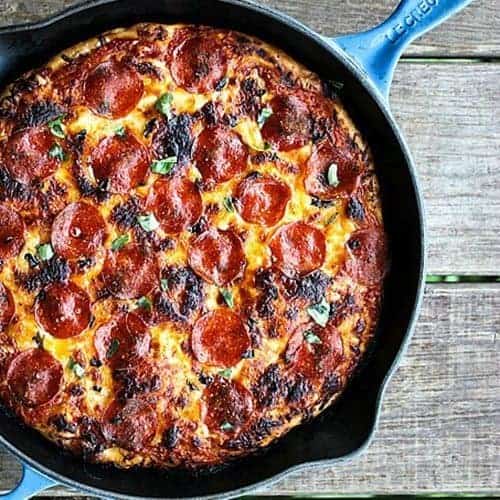
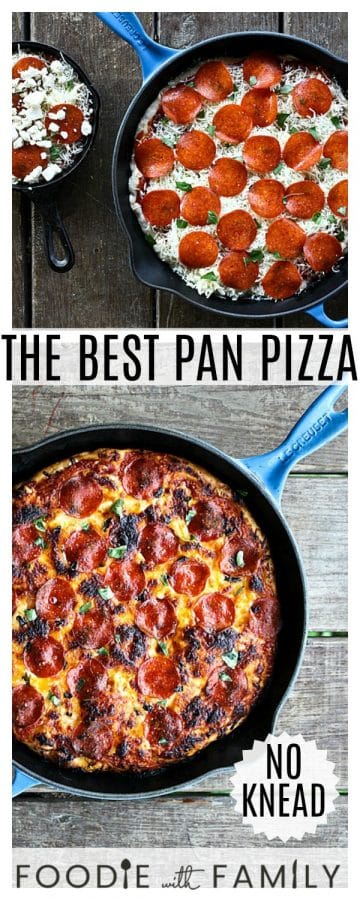



Reader's Thoughts...
Sue says
Looks sooo easy and delicious!!!
Sharron Trimm says
Loved the pizza, it was excellent , the crust was perfect.
Invite my sister and brother in law to eat pizza and they loved it also. Will make it real so again. It’s a keeper
Jeff says
Is peanut oil good or bad?
In the ingredient list it looks like it says no peanut oil, but in the cook’s notes peanut oil is good.
Rebecca says
Hi Jeff- I’m not sure what happened there. The “not extra virgin” was moved to the front of the list instead of coming AFTER peanut, canola, vegetable. Any neutral oil or peanut oil works well! I’ve fixed the recipe card to reflect that!
Chiara says
This looks yummy could send to Chiararosita9@gmail.com. would like all your recipes. Thsnks Chiara
Allison F says
I didn’t go through all the comments but has anyone notice it calls for 14 ounces of flour, about 2 1/2 cups? If there are 8 oz in 1 cup, isn’t 2 1/2 cups 20oz?
Rebecca says
Hi Allison,
In liquid volume, there are 8 ounces per cup. However, in this case, we are talking about ounces of weight not ounces of volume. Most flours average about 4.5 ounces per cup by weight. As the flour weighs 4.5 ounces per cup, 2.5 cups is equivalent to roughly 13.5 or 14 ounces by weight.
Allison F says
Ooooo… Thank you so much for the clarification!! It came out great!
Mark K says
Could you explain that math a bit further. 4.5 ounces per cup x 2.5 cups = 11.25 ounces? I’m not trying to be a jerk, just want some clarification on the numbers as a differences of almost 3 ounces in these proportions seems like it could be a big deal.
Rebecca says
Hi Mark- Go with the weight when in doubt! 14 ounces is the ideal starting point for this recipe.
Mark K says
Thanks Rebecca. I made this recipe tonight and it came out great. Did everything by weight and gave it about 24 hours for the initial rise. I agree with your assertion that the cast iron pan is the way to go. I did one in a case iron skillet and one in a heavy stainless steel frying pan. The frying pan one was fine, but the cast iron one had that extra bit of crispiness that really makes this dish.
Darci says
my dough seems watery
Rebecca says
The dough is far more slack than you’re probably used to seeing with dough. Try to ride it out 😀
Carrie says
This is the Bomb! Closest pizza to PH (love their chewy thick crust), but better yet, I know what I’m eating! Nice treat once in a while (or maybe now it will become every Friday Pizza Night)! Thanks for posting this recipe!
Side note Gimme Some Oven is one of my favorite food blogs. I’m now going to follow you too!
Rebecca says
*virtual high five* Carrie! I love Gimme Some Oven, too. And boy do I love this pizza! <3 I'm so glad you like it. Welcome!
Cindy courtney says
Can the dough be frozen? If so, at what stage?
Made this over the weekend, OMG awesome!
Rebecca says
It sure can! I’d say after the first rise is a good time to freeze it. I’m glad you loved it.
Ann Cassler says
So I saved this recipe and couldn’t find it when I was ready to make my pizza. I found another that I thought was it but it wasn’t. I started with my regular artisan bread dough recipe similar ratio of flour to water but more yeast and less rising time. 3 1/4 C flour, 1 1/2 C warm water, 3/4 T yeast. Stir and let rise on the counter 2 hours.
My dough is sticky unless I use a lot of flour when forming the ball and I didn’t want to use flour so I oiled my hand and scooped out some dough and plopped it into the skillet that was set on med high on the stove and patted it out. When the bottom was light brown I topped it with tomato sauce and cheese and put it in my 550 degree preheated oven. I baked it for about 15 minutes until the cheese was starting to brown in spots.
In short, I like your way better–skipping the stove top part. But I never let the dough rise again for pizza, only for loaves.
For pizza I scoop it out, pat it or roll it out and top it. The difference now for which I thank you a lot is that I’m working with oil and not flour and baking in the same skillet I pat it out in. Neat! Less time, less mess, FAR better tasting crust.
Thank you, thank you, thank you.
Rebecca says
You’re very welcome, Ann! I’m so glad you enjoy it!
Anna says
Oh boy, I’m totally late to the show. But better late than never I guess. I just have one quick question before I try this out, when you let the dough rise, is it left to rise in a warm area such as the oven or in the fridge overnight or whenever it is that it needs to rise? Thanks in advance! I can’t wait to try this!
Rebecca says
Hi Anna! I usually leave it out on a counter top to rise. I can’t wait to hear what you think of it!
Anna says
My word! I couldn’t wait to try this pizza and made it for dinner today! We absolutely loved it and will be making this as our new crust from now on! Just one thing, I had oiled the enameled cast iron pan but for some reason it stuck to the pan really badly. The normal cast iron didn’t stick. We somehow got the pizza out and of course ate it. But it was weird that it stuck so badly to the pan. I’m buying a second normal cast iron pan tomorrow so its all good! Thank you so much for this recipe. It’s a keeper!
Rebecca says
That is awesome, Anna! I’m so glad you love it!
Jan says
I will try this great recipe. Need to get the gluten flour.
Raquel says
Wow! I wasn’t sure about the small amount of yeast that was used, but boy was I wrong! I used half a recipe of dough and two 8-inch skillets for hubs and I. Fantastic crispy chewy crust. Thanks loads!
Rebecca says
Hooray, Raquel! I know it seems like an abnormally small amount of yeast, but it really does yield a delicious, chewy, crispy crust. I’m so glad you liked it!
Venita says
Can you use just regular all purpose flour in place of high gluten bread flour ? What what i need to do to make it work? Thank you for your reply
Rebecca says
Hi Venita- I think it will absolutely work with ap flour, but just end up with a slightly different texture!
Stacey says
I used this recipe to make pizzas 2 nights ago. I followed the recipe exactly. I live in Oklahoma (not exactly desert land) but did have to add an extra 9 tablespoons of water to get the dough to the consistency shown. I only let the first rise go for 8 hours, second rise (in pans) for 2 hours. Baked at 550 degrees for 20 minutes. I used a homemade pizza sauce and lots of toppings. I used two 12″ cast iron skillets. They turned out incredibly amazing! Cooked all the way through, light, airy, and crispy. They were so good, I’m making them AGAIN tonight. 🙂 This recipe doesn’t disappoint.
Rebecca says
I’m so glad you liked it, Stacey! Thanks for taking the time to give your feedback!
Carolyn Sills says
Would this pizza recipe turn out ok if you done it in a round pizza pan.
Rebecca says
Hi Carolyn-
I’m not sure what size your pan is or how deep it is, so I’m afraid I don’t know how to advise you here. I’ve only tested it in a round standard cake pan and a cast-iron pan. It worked well in both of those!
Lorraine says
I made this with all purpose flour and let it rise for 15 hours. It didn’t rise as much as the picture. I put a little too much oil in the pans so it was a little greasy but boy was it crisp and delicious. I want to try it again with the flour recommended in the recipe and with less oil.
Mae Hensley says
What can I use for a topping instead of pepperoni? (nothing pork) . I have a cast iron pan that my grandmother used, then my mother, now me. But they are available anywhere now. Just get one, season it according to directions and USE it! Then hand it down to your grand kids. Mae Hensley author of Wild Strawberries—- available at Amazon.com.
Rebecca says
Feel free to top as you prefer, Mae!
Carol says
I have a couple heavy well made pans but no cast iron, will it be ok?
Rebecca says
I’d give it a go! Please let us know how it turns out for you!
Lucky Fishing Charters says
Nice and easy. I’ll try it!!! Hopefully the dough will come out right.
Nancy Battersby says
The best cast iron skillets are sold at yard sale, I bought all mine there and use them all the time.